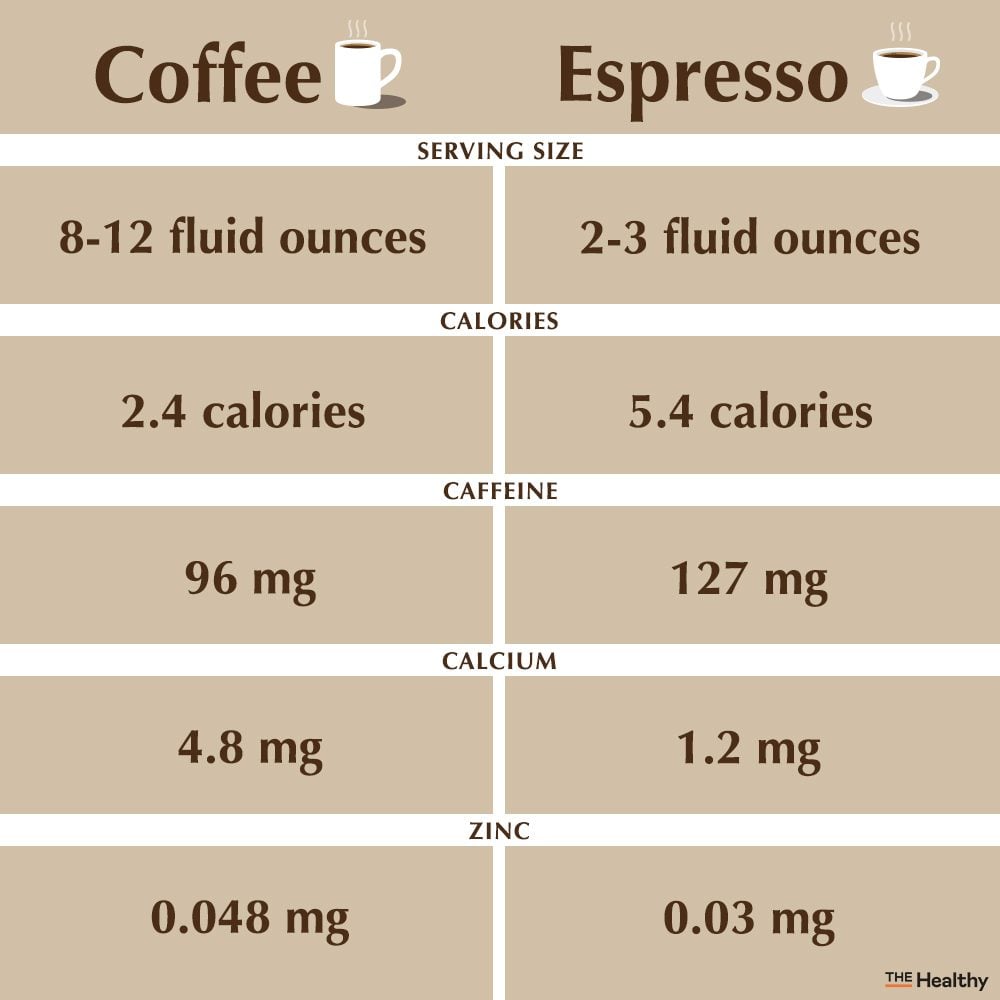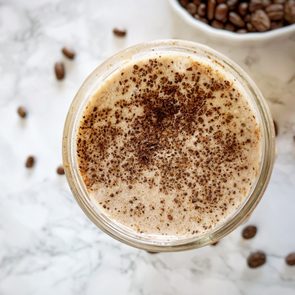Espresso vs. Coffee: The Difference Between 2 Caffeinated Favorites
Updated: Jul. 28, 2021
Read up, coffee lovers. Nutrition experts compare espresso vs. brewed coffee, including their calories, nutrition, potential health benefits, and caffeine levels (in both full-strength and decaf).
Caffeine 101
Some people claim that the only “true” coffee is a tiny cup of espresso. Others are diehard fans of a simple cup of drip joe.
Both are delicious caffeinated drinks, but is one better than the other?
Here’s what sets them apart, plus everything else you need to know about how espresso and coffee differ.
Espresso vs. brewed coffee
Espresso means “express” in Italian, a hint at one way it’s different than coffee, says Megan Meyer, the director of science communication at the International Food Information Council Foundation.
“The process takes about 25 seconds to brew a 1-ounce shot and requires a special machine or pot to make it,” she says.
While drip and pour-over coffee send hot water over coffee grounds (over a longer period of time), espresso is made by forcing boiling water or steam under pressure through finely-ground coffee beans.
The hot water, pressure, and very finely ground beans make this an intense beverage, says registered dietitian nutritionist Lisa DeFazio, RDN. The concentrated drink is a smaller serving size than a regular cup of drip coffee, about 1.5 to 2 oz.
There are some basic similarities between the two beverages, too. Coffee and espresso both contain caffeine and are made from coffee bean, typically robusta or Arabica beans, which have a bold flavor, DeFazio says.
(Switch things up with this dalgona coffee recipe.)

Which has more caffeine?
Ounce for ounce, espresso has about five times the amount of caffeine as brewed coffee, Meyers says. Typically, a 1-ounce shot of espresso contains between 40 and 75 mg of caffeine (a 2-ounce cup would be 127 mg), while an 8-ounce cup of coffee contains anywhere from 85 to 185 mg , according to DeFazio.
“Espresso has a higher concentration of caffeine per ounce,” DeFazio says. “A few sips of espresso gives you a boost of energy.” It may take at least two cups of coffee to get the same boost of energy.
But there are some other things to consider. Although espresso has a more concentrated caffeine content, serving sizes of espresso are smaller than those of brewed coffee, says Malina Malkani, RDN, a registered dietitian nutritionist and author.
If you are a decaf fan, know that both beverages can be made from decaffeinated coffee beans. (This is how much caffeine is in decaf coffee.) In that case, a 2-ounce cup of decaf espresso contains about 0.6 mg of caffeine, and an 8-ounce cup of brewed coffee contains 2.4 mg of caffeine.
Espresso calories vs. coffee calories
Although both espresso and regular coffee contain mostly water, they are not calorie-free. One cup (8 fluid ounces) of brewed coffee has 2.4 calories.
One standard cup of espresso (2 fluid ounces) has 5.4 calories. Note that espresso contains more calories per ounce than coffee because it’s concentrated.
However, a typical cup of espresso is a smaller serving size than that of an average coffee cup. Adding in any mix-ins like cream, milk, or sugar to either beverage also increases calories.
Which has more antioxidants?
Coffee contains antioxidants like flavonoids and polyphenols that can decrease oxidative stress (which plays a role in disease development) by eliminating damaging free radicals, says Malkani. More specifically, Meyers points to chlorogenic acid, ferulic acid, caffeic acid, and n-coumaric acid as key antioxidants in coffee.
“Several factors affect the antioxidant profile of coffee beverages, including the brewing method and bean variety,” Meyers says.
One 2020 study in the journal Foods found that the brewing method impacts mineral content and antioxidant activity, as well as the acidity of coffee.
The researchers looked at five coffee brewing techniques: Aeropress, drip, espresso machine, French press, and simple infusion. (Learn why french press coffee is bad for you.)
They found the highest levels of calcium in coffee from the espresso machine and the lowest level in the drip-brew. Coffee from the espresso machine was the richest source of zinc.
When it came to antioxidant potential, AeroPress coffee came out on top, with the most polyphenols. (Does coffee cause inflammation?)
What impacts antioxidant content?
The brewing method of espresso vs. coffee can affect antioxidant levels. But the coffee beans themselves also play a role in whether one cup is more antioxidant rich than another. That goes for both coffee and espresso, which are brewed from the same beans.
Consider the quality, age, and freshness of the coffee beans. How the beans were farmed, the soil where they grew, how long they were roasted, how long it has been since they were ground, and the extraction process used to prepare them all have an impact, Malkani says.
Espresso may have an advantage over drip coffee in terms of antioxidant content, given that coffee beans are typically ground right before making espresso, Meyers says.
Many drip-coffee drinkers use pre-ground coffee that sits in the pantry and on store shelves prior to use. And the longer coffee beans sit ground, the greater their antioxidant loss.
Overall, though, debating esspresso vs. coffee based on each drink’s antioxidant content may not not be as helpful as Malkani’s recommendation: Pay close attention to the coffee beans you use. (Here’s how much coffee you can drink daily.)
“While these antioxidants can contribute to overall health, what is most important is to make sure you are eating a well-balanced diet full of fruits and veggies, lean protein, healthy fats, and whole grains,” Meyers says.
Are there any other nutritional differences?
Nutritionally, both espresso and drip coffee without add-ins are similar. Both contain small amounts of some B vitamins, magnesium, and manganese, says Malkani.
According to research in Nutrition Reviews and Neurology, these may help reduce the risk of developing various diseases, including type 2 diabetes and Parkinson’s disease. Other studies, published in World Journal of Hepatology and BMC Cancer, found that coffee may help prevent liver disease and some types of cancer, too. (Here are other surprising health benefits of coffee.)
The paper filters used during the brewing of regular coffee may help remove diterpenes. These substances can cause an increase in low-density lipoprotein (LDL) cholesterol, the type of cholesterol linked to heart disease. The ability to filter out diterpenes may give filtered coffee an edge over espresso in terms of an overall impact on health.
In fact, an April 2020 study in the European Journal of Preventive Cardiology found that filtered brew is linked to a lower mortality rate than unfiltered coffee, as long as you stay below five cups a day.
The bottom line: Espresso vs. coffee
Both espresso and coffee contain caffeine (even decaf versions have a little bit) and are made from coffee beans. One isn’t necessarily healthier than the other.
“What’s most important, and is recommended by the Food and Drug Administration and U.S. Dietary Guidelines for Americans, is that you stay below 400 milligrams of caffeine per day,” Meyers says. (Here are the signs you’re drinking too much coffee.)
The espresso vs. coffee health debate may come down to how you dress them up.
“In other words, a cup of black coffee is healthier than an espresso drink with syrup, sprinkles, and milk,” says Malkani. “But a plain shot of espresso will not increase total calories, fat, and sugars as much as a cup of coffee with cream and sugar.”
So whether your favorite is espresso or regular drip coffee, be mindful of how much caffeine you consume, where you get your coffee beans, and anything else you add to your drink.
Next, check out the truth on whether coffee can dehydrate you.























